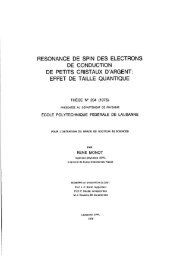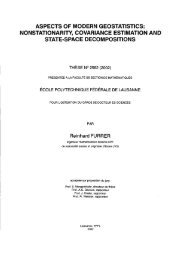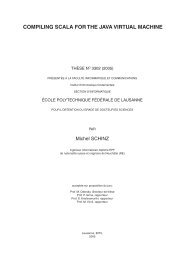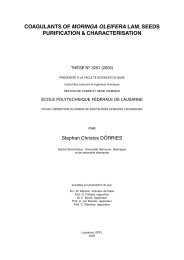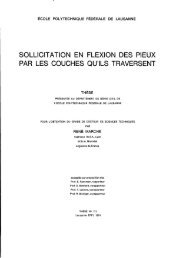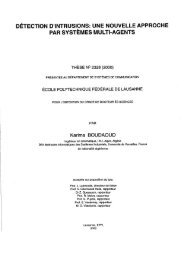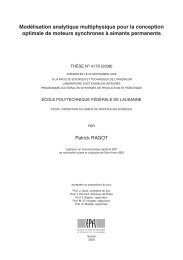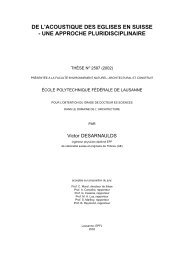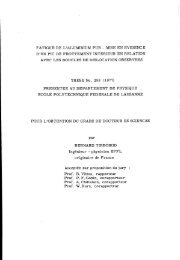optimisation et simulation numérique du chauffage par ... - EPFL
optimisation et simulation numérique du chauffage par ... - EPFL
optimisation et simulation numérique du chauffage par ... - EPFL
You also want an ePaper? Increase the reach of your titles
YUMPU automatically turns print PDFs into web optimized ePapers that Google loves.
OPTIMISATION ET SIMULATION NUMÉRIQUE<br />
DU CHAUFFAGE PAR INDUCTION POUR LE PROCÉDÉ<br />
DE THIXOFORMAGE<br />
PRÉSENTÉE A LA FACULTÉ SCIENCES DE BASE<br />
Institut d'analyse <strong>et</strong> de calcul scientifique<br />
SECTION DE MATHEMATIQUES<br />
ÉCOLE POLYTECHNIQUE FÉDÉRALE DE LAUSANNE<br />
POUR L'OBTENTION DU GRADE DE DOCTEUR ks SCIENCES TECHNIQUES<br />
PAR<br />
Alexandre MASSEREY<br />
ingénieur physicien dip!6rn6 EPF<br />
de nationalité suisse <strong>et</strong> originaire de Venthbne (VS)<br />
acceptée sur proposition <strong>du</strong> jury:<br />
Prof. J. Rappaz, directeur de thèse<br />
Prof. J. R. Mosig, rapporteur<br />
Dr M. Plata, rapporteur<br />
Prof. R. Touzani, rapporteur<br />
Lausanne, <strong>EPFL</strong><br />
2003
Résumé<br />
Daiis ce travail, nous iious iritéressons au coritrôle optimal <strong>du</strong> cliaiiffage <strong>par</strong> iricluctiori.<br />
C<strong>et</strong>te prol~lérriatique a été posée <strong>par</strong> notre <strong>par</strong>tenaire iritlustriel Alcan tlaus<br />
le cadre d'iiri procédé iri<strong>du</strong>striel de fahricatiori de piéces d'alurniiiiiirri appelé tliixoforrriago.<br />
Au cours de la fabricatiori, ori clinuffe <strong>par</strong> iritliictiori iirie bill<strong>et</strong>,t,e (t'alliage<br />
rl'aluniiriiurri jusqu'à uri état serrii-solide <strong>par</strong>ticulier appel6 état tliixotrope, avant de<br />
I'irijecter, sous pression, tlaris uri moule. La qualit,é de la pièce obteriiie (Iéperi
La rriéttiode airisi développée a été iniplaritée daris uri code de sirriulatioii bidirneri-<br />
sionriel de ctiauffage <strong>par</strong> iritluctiori déjà existant. Nous présentons des tests riuniériques,<br />
des résultats d'<strong>optimisation</strong> <strong>et</strong> une coni<strong>par</strong>aisori avec des résultats expérirnentaux. Nous<br />
rriorit.roiis airisi l'efficacité de notre niéthode pour le coritrole optimal <strong>du</strong> ctiauffage <strong>par</strong><br />
iri(1iictioii. Nous firiissons notre exposé <strong>par</strong> la corri<strong>par</strong>aison de résultat,^ ot~teriiis <strong>par</strong><br />
la rriétliode (le l'état adjoirit avec ceux obt,erius <strong>par</strong> diKéreritiatiori autorriatique. Nous<br />
rri<strong>et</strong>toris ainsi en évidence les avantages <strong>et</strong> les iriconvériierits de c<strong>et</strong>te dernière.
Abstract<br />
In t,his work, we are interested iri tlie optimal coritrol of tlie inrluctiori heatiiig pro-<br />
cess. This problerri has beeri posed by our iri<strong>du</strong>strial <strong>par</strong>trier Alcari withiri the frarrie-<br />
work of ari iritlustrial process of manufacture of aluniiriiurri <strong>par</strong>ts, called tliixoforrnirig.<br />
Duririg the rriaiiufacture, one Iieats by iriciuctiori an aliirrii~iiiirri alloy bill<strong>et</strong> uritil a <strong>par</strong>-<br />
ticular serni-solid state, called thixotropic state, before injcctirig it, uritler pressure, iri a<br />
mould. Tlie quality of the <strong>par</strong>t obtairied clepends directly on ttie qiiality of the heatirig.<br />
The bill<strong>et</strong> rriust, have t,he rriost. liorriogerieous possihle t.erriperat,itre corresporidirig to<br />
apprmirriately 50 % of solid fraction to guararitee the coriforrriity of the niouldirig.<br />
Thus, it is very sigriificaiit to be able to optirriize the coritrol <strong>par</strong>arri<strong>et</strong>ers of the iri-<br />
<strong>du</strong>ctiori heatirig iri order to achieve this goal. Otlier <strong>par</strong>arri<strong>et</strong>ers can also be takeri irito<br />
accouiit to guararitee ttie qualit,y of tlie heat,irig. The coiitrol variables are the frequency<br />
aiid tlie terisiori (or power) siipplirtl to tlie iritlrictor. More precisely, we seek a power<br />
wliose arriplitude varies in tirrie.<br />
We use riurnerical analysis techniques to solve the optirrial coritrol problern. The<br />
whole proceedirig plienonieria, <strong>du</strong>ring the heating, are described by non-liriear <strong>par</strong>tial<br />
derivative equatioris. We work withiii a two-dirrierisiorial frarriework. We use t,wo riiirrierical<br />
rnodels allowirig t,o obtairi the rriagu<strong>et</strong>ic field h arid the entlialpy u iti talie piece.<br />
From physical corisitlerations, we huild ari objective functiori J ctiaracteristic of the<br />
control wliicli orle warits to carry out. By a perturbatioris rri<strong>et</strong>hod, we tlieri seek to calculate<br />
the gradierit of tlie cost fuiictiori followirig the coritrol <strong>par</strong>ani<strong>et</strong>ers. This tecliriiqiie<br />
bririgs 11s to tlie calciilatiori of two associated acljoirit problerris, orle for electrorriagri<strong>et</strong>isrri,<br />
the other for thermies. These problerns heirig solv<strong>et</strong>l, it is pomible to evaliiate the<br />
gradierit of the ot>.ject,ive fuiictiori. Tlie value of coiitrol variables, the gratlierit and the<br />
furictiori J are theri trarisrriitted to a descerit algoritlirri based or1 a quasi-Newton wliich<br />
gives us the riew s<strong>et</strong> of <strong>par</strong>ani<strong>et</strong>ers. Theri, we reit,erate iiritil satisfyirig a stop criteriori<br />
deperidirig on tlie required precisioii. Firially, we obtairi the optirrial <strong>par</strong>arri<strong>et</strong>ers. For<br />
solvirig these prohlenis, we use a corribiriatiori of a firiite diff'ererice ni<strong>et</strong>liotl for the the discr<strong>et</strong>ixation arid of a finite elemerits ni<strong>et</strong>hoti for the space discr<strong>et</strong>iïiation.<br />
The so develop<strong>et</strong>l rri<strong>et</strong>hod was irriple~rieiited iri a already existiiig two-diiiierisioilal<br />
<strong>simulation</strong> code for iri<strong>du</strong>ctioii heatirig. We preserit riiirrierical tests, optirriixatiori results<br />
and a corn<strong>par</strong>isori with experirrierital results. We show like this the effectiveriess of<br />
our m<strong>et</strong>hod for t,tie optimal cont,rol of in<strong>du</strong>ctioii Iieating. We firiisli our study t>y the
corri<strong>par</strong>isori of the results obtairied by th adjoi~it<br />
state ni<strong>et</strong>lrod witlr tliose obtaitieci by<br />
autorrlatic differeritiatiori. Il'tius, we tiighligtit the atlvaritages arid the disadvaritages of<br />
this last one.
Table des matières<br />
Résumé i<br />
Abstract iii<br />
Remerciements v<br />
1 Intro<strong>du</strong>ction 1<br />
1.1 Bref historique <strong>du</strong> <strong>chauffage</strong> électrorriagnétique . ............. 3<br />
1.2 Ut. ilisation actuelle <strong>du</strong> cliaiiffage <strong>par</strong> in<strong>du</strong>ction <strong>et</strong> rnotivatioii ...... 5<br />
1.3 Plaiiiticat. iori (lu tlocurrie~it . ........................ 5<br />
1.4 Quelques résultats de sirriiilatioris ..................... 7<br />
2 Le procédé in<strong>du</strong>striel de thixoformage 9<br />
2.1 Le procédé <strong>et</strong> ses <strong>par</strong>ticularités ...................... 9<br />
2.2 Le procédé daris son ut.ilisat. ion cheï, Alcari ................ 14<br />
2.3 Les problèrries liés a ce type de coulée . .................. 15<br />
2.4 But <strong>du</strong> préserit travail ........................... 17<br />
3 Modélisation 19<br />
3.1 Description pliysiqiie <strong>du</strong> problèrne ..................... 20<br />
3.2 Préseritatiori tl'iiri nioclèle de cliauffage <strong>par</strong> iridiictiori bidiriiensio~inel . . 21<br />
3.3 Modélisation (le 1'Clectrorriagiiétisrrie .................... 22<br />
3.4 Modéli~at~iori de le tlier~niqrie . ...................... 34<br />
3.5 Ecriture <strong>du</strong> problème couplé ........................ 41<br />
4 Problème de contrôle optimal 45<br />
4.1 Ecriture <strong>du</strong> problénie de corttrôle ..................... 46<br />
4.2 Dérivation <strong>du</strong> systèrrie d'optirrialité .................... 52<br />
4.3 Piocé<strong>du</strong>re d'<strong>optimisation</strong> .......................... 64<br />
4.4 Résolution riuniérique <strong>du</strong> systèrrie tl'optirrialité .............. 73<br />
5 Mise en oeuvre <strong>et</strong> tests <strong>numérique</strong>s 75<br />
5.1 Mise eri oeuvre sur ordiiiateur ....................... 75<br />
5.2 Tests <strong>numérique</strong>s .............................. 78<br />
5.3 Conclusioris ................................. 104<br />
vii
...<br />
v111 TABLE DES MATIERES<br />
6 Simulation numériquie d'un probléme in<strong>du</strong>striel 105<br />
6.1 Approxirriatioris



